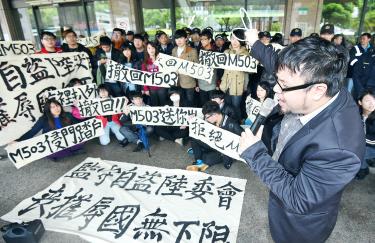About 40 members of the Restoration of Taiwan Social Justice group clashed with police yesterday after staging a surprise protest against a controversial Chinese flight route at the Mainland Affairs Council (MAC) offices, calling on MAC Minister Andrew Hsia (夏立言) to step down.
The M503 flight route — which runs close to the median line of the Taiwan Strait and is scheduled to be inaugurated on Sunday — has come under heavy criticism from many in Taiwan.
Critics say that it could endanger national security and that it circumvents legislative oversight.
The route was an arbitrary announcement by China, the group’s chief executive, Lin Yu-lun (林于倫), said, adding that even after negotiations with President Ma Ying-jeou’s (馬英九) administration, Beijing only agreed to move the flight route westward by 6 nautical miles (11km), placing it 10.2 nautical miles from the median line of the Taiwan Strait.
The route is not an “international civilian route with no flight security risks,” Lin said, adding that it is a Chinese ploy to turn the Taiwan Strait into Chinese territorial waters.
It is difficult to continue to have faith in the council’s slogan touting itself as the gatekeeper of Taiwan in light of the government’s pursuit of China-friendly policies and its acceptance of a policy that seriously undermines Taiwanese sovereignty, Lin said.
Protesters scuffled briefly with police before being forced outside, where they gathered until a council representative accepted a letter of protest.
Lin demanded that the council issue a response no later than today or the group would launch a larger-scale demonstration.
Separately, National Security Bureau Director-General Lee Shying-jow (李翔宙) said that public fears that the People’s Liberation Army Air Force (PLAAF) would conduct regular patrols west of the median line after the M503 route is launched are unfounded.
Having international flight routes close to the median line of the Taiwan Strait means that the PLAAF would keep its patrols even closer to the Chinese coast, giving Taiwan more room in terms of response time, Lee told a meeting of the legislature’s Foreign Affairs and National Defense Committee.
Critics of the M503 route have said the normalization of the route would mean increased PLAAF patrols west of the median line.
Lee said that incidences of Chinese jets breaching the median line were dealt with on a “case-by-case basis.”
Chinese Nationalist Party (KMT) Legislator Lin Yu-fang (林郁方) rejected the claim, saying that since former president Lee Teng-hui (李登輝) sparked tensions by defining the cross-strait relationship as a “special state-to-state” relationship in 1999, the PLAAF has flown 1,100 patrols near the median line each year.
The continued provocation by Chinese jets west of the median line are not “case-by-case” incidents, Lin said, asking Lee whether the M503 route forcing the Chinese jets to retreat from the median line was what he meant by a successful negotiation.
Lee said that since 1999, China has presumably extended patrol parameters from 10 nautical miles from the coast to just west of the median line, adding that there are six to 12, or even 18 to 24, Chinese jets patrolling per day.
With its domestic A470 flight route heavily congested and Beijing agreeing to move the M503 path westward, the world can see that the Chinese have turned what was once combat patrol airspace into international commercial airspace, Lee said.
The westward shift of the PLAAF patrol routes means that Taiwan would gain significant anti-aircraft warning time, Lee said.
Additional reporting by CNA AND AFP
Source: Taipei Times - 2015/03/27





















